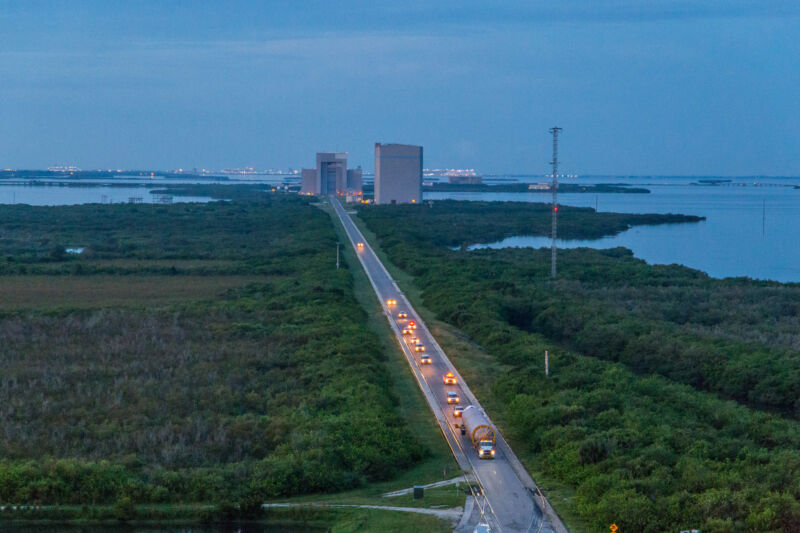Hurricane Ian cut a devastating swath across Florida this week, and its core passed directly over Kennedy Space Center and Cape Canaveral on Thursday.
However, by then, Ian had weakened to become a moderately strong tropical storm, with the bulk of its heaviest rainfall to the north of the launchpads along the Atlantic coast. As a result, damage to NASA's launch facilities at Kennedy Space Center, and the Space Force launchpads at Cape Canaveral, was minimal.
Accordingly, by Friday, work was already underway at facilities along Florida's "Space Coast" for a rapid-fire succession of three launches in three days.
SES-20 and SES-21
First up is a commercial mission on United Launch Alliance's Atlas V rocket to launch SES-20 and SES-21 satellites for Luxembourg-based satellite operator SES. Stacked in its "531" configuration, this Atlas rocket has a five-meter-diameter payload fairing, three solid rocket boosters, and one engine on the upper-stage Centaur.
On Friday, United Launch Alliance said everything continues to progress toward the launch of this mission on Tuesday, October 4, from Space Launch Complex-41 at Cape Canaveral Space Force Station. The launch is planned for 5:36 pm EST (21:36 UTC). Weather is forecast to be favorable, with a 70 percent chance of favorable conditions for launch.
After launching, the Atlas V rocket will deliver the pair of communications satellites into near-circular, near-geosynchronous orbits. Once separated, the satellites will use onboard propulsion systems to circularize their orbits at 35,900 km above the equator.
Crew-5
Next up in Florida is NASA's Crew-5 mission, which will launch on a Falcon 9 rocket to the International Space Station. NASA officials confirmed this mission remains on schedule for noon EST (16:00 UTC) on October 5 from Launch Complex-39A at Kennedy Space Center.
The crew of four—NASA astronauts Nicole Mann and Josh Cassada, Japan Aerospace Exploration Agency astronaut Koichi Wakata, and Roscosmos cosmonaut Anna Kikina—have been holding at Johnson Space Center in Houston pending the outcome of Hurricane Ian. However, they will now fly to Florida on Saturday in preparation for the launch.
SpaceX, meanwhile, will roll its Falcon 9 rocket with the Crew Dragon spacecraft to the launchpad on Friday night or Saturday, ahead of a static fire test on Sunday. There appear to be no significant technical issues to be worked on ahead of the launch next Wednesday.
Galaxy 33 & 34
Finally, on October 6, SpaceX plans an additional launch. For this mission, from Space Launch Complex-40 at Cape Canaveral, a Falcon 9 rocket will deliver Intelsat's Galaxy 33 and 34 satellites telecommunications satellites into a geostationary transfer orbit. The launch is set for 7:07 pm EST (23:07 UTC).
Of note for this mission, this Falcon 9 first-stage booster will be making its 14th launch. This marks the first time a SpaceX rocket has flown a purely commercial payload on its 10th flight or later. This strongly suggests that the commercial satellite market is becoming increasingly comfortable with SpaceX's refurbishment process for even well-used rockets.
Artemis I
NASA also said on Friday that its Artemis I hardware survived Hurricane Ian just fine, safely tucked inside the large Vehicle Assembly Building at Kennedy Space Center. The agency will aim to have the rocket ready for a launch attempt in about six weeks.
"As teams complete post-storm recovery operations, NASA has determined it will focus Artemis I launch planning efforts on the launch period that opens Nov. 12 and closes Nov. 27," NASA said in a blog post. "Over the coming days, managers will assess the scope of work to perform while in the VAB and identify a specific date for the next launch attempt."
In the coming days, engineers and technicians will extend access platforms around the Space Launch System rocket and Orion spacecraft inside the Vehicle Assembly Building to conduct inspections, and start preparing for the next launch attempt, including retesting the flight termination system.
The rocket and spacecraft have been in this fully stacked condition for more than 11 months, so NASA wants to make sure that all of the various batteries, stored propellants, and other "life limited items" on the vehicles are still in good working condition before rolling out to the launchpad again.



3175x175(CURRENT).thumb.jpg.b05acc060982b36f5891ba728e6d953c.jpg)

Recommended Comments
There are no comments to display.
Join the conversation
You can post now and register later. If you have an account, sign in now to post with your account.
Note: Your post will require moderator approval before it will be visible.